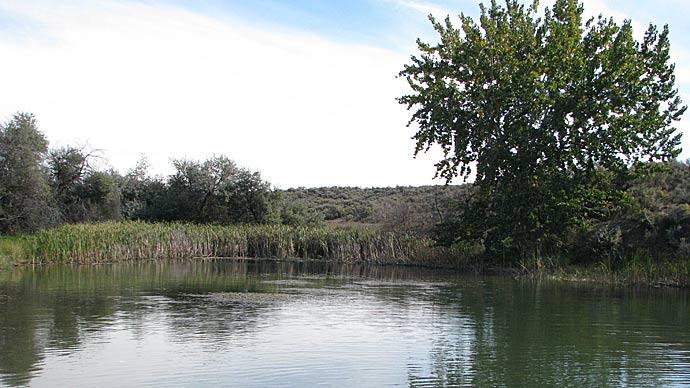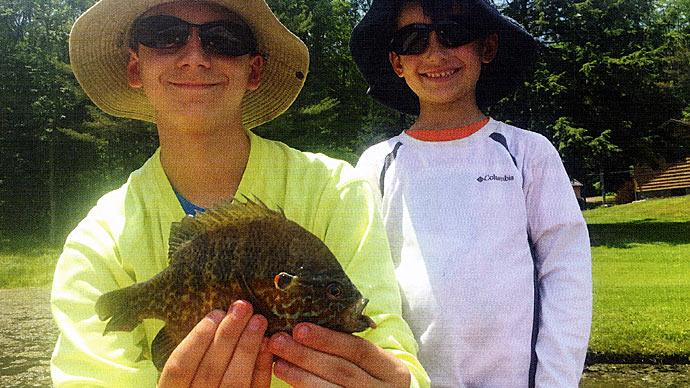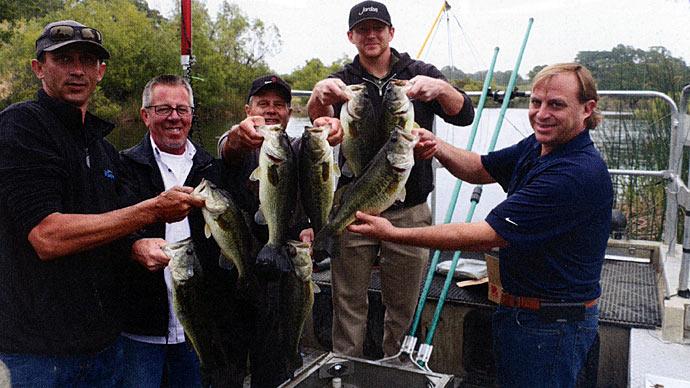
There just is no way to sugar-coat this. The sex life of bluegill is X-rated. Rowdy males are the culprits.
Scientists call this topic area "behavioral ecology." They typically discuss what "strategies" are used by an organism to increase its likelihood of passing genes on to the next generation. Male bluegills actually have alternative strategies. They may be "parental males" or they may be "cuckolders." Really, that's a word.
Bluegills are colony spawners. They excavate saucer-shaped nests, usually in a group which resembles similar size craters. Once you've seen a spawning colony of 20 or 30 depressions in shallow water, you always recognize them. Some colonies are much larger. Comparatively, largemouth and smallmouth bass nest are quite similar in shape and appearance, but are somewhat larger and solitary. Always solitary.
For those of you who happen to be interested in birds, bluegill colonies are very much like the "leks" or dancing grounds for birds such as prairie chickens or sharp-tailed grouse.
Most Pond Boss readers probably recognize the most common reproductive strategy used by male bluegills. They are called "parental males." Adult male bluegills develop a large black tab on the back of their gill cover. Kayla Condello is holding a big parental male bluegill on the cover of the March/April 2005 Pond Boss. By the way, what a smile, eh? You'd think her dad was a dentist.
Parental males normally grow to a large size before maturing. The advantage to this largeness is a result of fish physiology. Fish consume a given amount of energy (food) during a given year. While the fish is still immature, a large portion of energy can be used for body growth. Once a fish matures, some or even most energy will be diverted to gonads. Males mature testes that produce milt, and females mature ovaries which produce eggs. At the onset of maturity, fish growth generally slows because of this diversion of energy. If you want to grow big bluegills in your pond, the later in life they mature, the better. By putting off sexual maturation, bluegill grow to much larger sizes.
Consequently, in a well balanced bluegill population, parental males grow to a large size before sexual maturity. Bigger bluegill dominate nests within a spawning colony. There is some evidence of an actual hierarchy in nest sites, with the most "dominant" males getting the most desirable central nests and being most likely to attract a female for spawning.
"Cuckold males" actually come in two varieties. Here is where X-rating starts to become obvious. The smaller type of cuckold males is termed a "sneaker." When a parental male is spawning with a female, the sneaker darts into the nest, releases milt in an attempt to fertilize some of the eggs, and then gets out of there before the big male can get after him. In videotapes I have seen, these "darts" are really quick!
The other type of cuckold male is termed a "female mimic." These males actually adopt the coloration of a female bluegill. When a parental male is spawning with a female, the female mimic will approach the female from the opposite side, and release milt to fertilize some of the eggs. The parental male does not chase away this female mimic, likely because of the female coloration pattern.
One of the experts in bluegill reproductive behavior is Dr. Bryan Neff at the University of Western Ontario in London, Ontario. At his geographic location, he finds sneaker males mature at 2-3 years of age, female mimics mature at 4-5 years of age, and the parental males do not mature until age 7 or 8. These ages may vary somewhat by geographic location, but they give you a sense of the large difference in age at maturity given the reproductive strategy of males. Cuckolds do not live as long as parental males, and never reach the parental size and status. So, they may pass on their genes at a young age, but they do not live as long.
Fish truly have complex social behaviors, and we are just now starting to understand some of them. I suspect this is because fish are in an environment in which they are hard to see. Let me pass on one amazing "factoid" on bluegill reproduction. It appears male bluegills may be able to differentiate between their own offspring and offspring from cuckold males once the fry hatch in the nest! Current thought by researchers is that males can tell the difference by their sense of smell. Some males have been observed selectively eating some of the fry in the nest, and we assume these are the offspring from the cuckold males! Now honestly, isn't that amazing??
So, what are the management implications of this reproductive behavior in bluegills? Well, Dr. Bruce Condello actually started this discussion for us in the March/April 2005 issue of Pond Boss. Our initial concern within the fisheries profession was harvesting the big parental male bluegills may create a genetic advantage for the cuckolds. Could we shift more of the population to cuckolds in the long-term because of fishing pressure? Certainly we don't want to create a population of small bluegills in your pond.
Well, a lot of research has gone into this topic, especially in the large, natural lakes in northern Michigan, Minnesota, and Wisconsin, and southern Ontario. To date, evidence has been sparse, and genetic changes over time have not been documented. However, one research biologist with the Minnesota Department of Natural Resources found the length at which his male bluegills matured actually increased by about 1 inch (from 7 inches to 8 inches) after he reduced harvest of big bluegills. Unfortunately, he could only show this response in two of four study lakes, probably meaning other factors are also involved.
What about ponds? Well, I suspect there probably should not be as much concern over genetically increasing the abundance of cuckolds in ponds managed with largemouth bass and bluegills. Can you think of any advantage for a male bluegill to stay small and vulnerable rather than growing large when it lives in a pond full of effective predators such as largemouth bass? I can't either. However, as Dr. Condello indicated in his article, harvest strategies could affect size of parental males in your pond. If you harvest excessive numbers of big males, parentals will start to mature at a smaller size. Remember, once they mature, growth slows. All of a sudden, big males may only be 6-7 inches, rather than 8-10 inches long! In such a situation, you probably should cut back on your harvest of the biggest males. It may even help to harvest the 7-8 inch males, and release 9 inch and longer males, depending, of course, on the size structure of bluegills that you are producing.
So there you have it. X-rated bluegills playing all kinds of reproductive games in Bob Lusk's family-oriented magazine. What is the world coming to? I'm going fishing.
Dr. David W. Willis is a professor in the Department of Wildlife and Fisheries Sciences, South Dakota State University in Brookings. He frequents the Pond Boss forum at www.pondboss.com and can be reached there.
Reprinted with permission from Pond Boss Magazine



